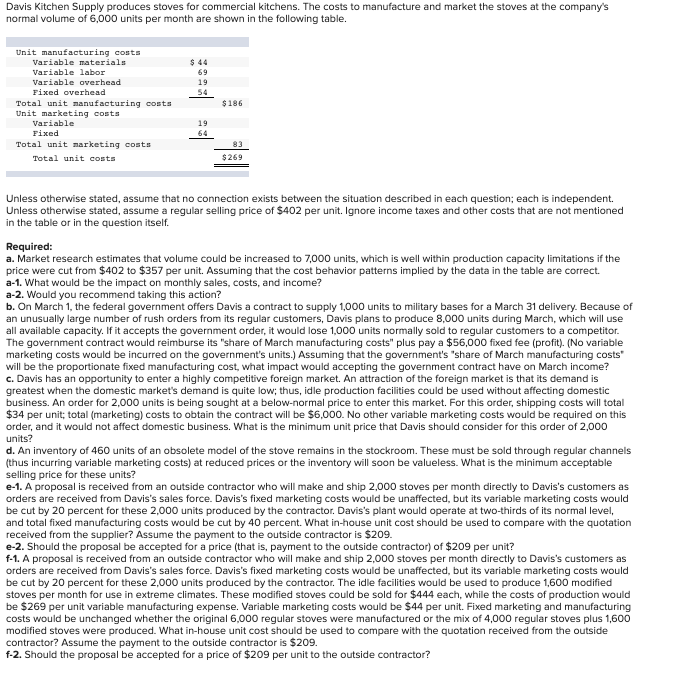Davis Kitchen Supply produces stoves for commercial kitchens. The costs to manufacture and market the stoves at the company's normal volume of 6,000 units per month are shown in the following table. Unit manufacturing costs Variable materials Variable labor Variable overhead rixed overhead Total unit manufacturing costs $186 Unit marketing costs Variable rixed Total unit marketing costs Total unit costs $269 Unless otherwise stated, assume that no connection exists between the situation described in each question; each is independent. Unless otherwise stated, assume a regular selling price of $402 per unit. Ignore income taxes and other costs that are not mentioned in the table or in the question itself. Required: a. Market research estimates that volume could be increased to 7,000 units, which is well within production capacity limitations if the price were cut from $402 to $357 per unit. Assuming that the cost behavior patterns implied by the data in the table are correct. a-1. What would be the impact on monthly sales, costs, and income? a-2. Would you recommend taking this action? b. On March 1, the federal government offers Davis a contract to supply 1,000 units to military bases for a March 31 delivery. Because of an unusually large number of rush orders from its regular customers, Davis plans to produce 8,000 units during March, which will use all available capacity. If it accepts the government order, it would lose 1,000 units normally sold to regular customers to a competitor. The government contract would reimburse its "share of March manufacturing costs" plus pay a $56,000 fixed fee (profit). (No variable marketing costs would be incurred on the government's units.) Assuming that the government's "share of March manufacturing costs" will be the proportionate fixed manufacturing cost, what impact would accepting the government contract have on March income?
Davis Kitchen Supply produces stoves for commercial kitchens. The costs to manufacture and market the stoves at the company's normal volume of 6,000 units per month are shown in the following table. Unit manufacturing costs Variable materials Variable labor Variable overhead rixed overhead Total unit manufacturing costs $186 Unit marketing costs Variable rixed Total unit marketing costs Total unit costs $269 Unless otherwise stated, assume that no connection exists between the situation described in each question; each is independent. Unless otherwise stated, assume a regular selling price of $402 per unit. Ignore income taxes and other costs that are not mentioned in the table or in the question itself. Required: a. Market research estimates that volume could be increased to 7,000 units, which is well within production capacity limitations if the price were cut from $402 to $357 per unit. Assuming that the cost behavior patterns implied by the data in the table are correct. a-1. What would be the impact on monthly sales, costs, and income? a-2. Would you recommend taking this action? b. On March 1, the federal government offers Davis a contract to supply 1,000 units to military bases for a March 31 delivery. Because of an unusually large number of rush orders from its regular customers, Davis plans to produce 8,000 units during March, which will use all available capacity. If it accepts the government order, it would lose 1,000 units normally sold to regular customers to a competitor. The government contract would reimburse its "share of March manufacturing costs" plus pay a $56,000 fixed fee (profit). (No variable marketing costs would be incurred on the government's units.) Assuming that the government's "share of March manufacturing costs" will be the proportionate fixed manufacturing cost, what impact would accepting the government contract have on March income?
Essentials of Business Analytics (MindTap Course List)
2nd Edition
ISBN:9781305627734
Author:Jeffrey D. Camm, James J. Cochran, Michael J. Fry, Jeffrey W. Ohlmann, David R. Anderson
Publisher:Jeffrey D. Camm, James J. Cochran, Michael J. Fry, Jeffrey W. Ohlmann, David R. Anderson
Chapter12: Integer Linear Optimization_models
Section: Chapter Questions
Problem 4P: Hawkins Manufacturing Company produces connecting rods for 4- and 6-cylindcr automobile engines...
Related questions
Topic Video
Question
Hello, I need help solving this accounting problem.

Transcribed Image Text:Davis Kitchen Supply produces stoves for commercial kitchens. The costs to manufacture and market the stoves at the company's
normal volume of 6,000 units per month are shown in the following table.
Unit manufacturing costs
Variable materials
$ 44
69
Variable labor
Variable overhead
19
Fixed overhead
54
Total unit manufacturing costs
Unit marketing costs
Variable
$186
19
Fixed
64
Total unit marketing costs
83
Total unit costs
$269
Unless otherwise stated, assume that no connection exists between the situation described in each question; each is independent.
Unless otherwise stated, assume a regular selling price of $402 per unit. Ignore income taxes and other costs that are not mentioned
in the table or in the question itself.
Required:
a. Market research estimates that volume could be increased to 7,000 units, which is well within production capacity limitations if the
price were cut from $402 to $357 per unit. Assuming that the cost behavior patterns implied by the data in the table are correct.
a-1. What would be the impact on monthly sales, costs, and income?
a-2. Would you recommend taking this action?
b. On March 1, the federal government offers Davis a contract to supply 1,000 units to military bases for a March 31 delivery. Because of
an unusually large number of rush orders from its regular customers, Davis plans to produce 8,000 units during March, which will use
all available capacity. If it accepts the government order, it would lose 1,000 units normally sold to regular customers to a competitor.
The government contract would reimburse its "share of March manufacturing costs" plus pay a $56,000 fixed fee (profit). (No variable
marketing costs would be incurred on the government's units.) Assuming that the government's "share of March manufacturing costs"
will be the proportionate fixed manufacturing cost, what impact would accepting the government contract have on March income?
c. Davis has an opportunity to enter a highly competitive foreign market. An attraction of the foreign market is that its demand is
greatest when the domestic market's demand is quite low; thus, idle production facilities could be used without affecting domestic
business. An order for 2,000 units is being sought at a below-normal price to enter this market. For this order, shipping costs will total
$34 per unit; total (marketing) costs to obtain the contract will be $6,000. No other variable marketing costs would be required on this
order, and it would not affect domestic business. What is the minimum unit price that Davis should consider for this order of 2,000
units?
d. An inventory of 460 units of an obsolete model of the stove remains in the stockroom. These must be sold through regular channels
(thus incurring variable marketing costs) at reduced prices or the inventory will soon be valueless. What is the minimum acceptable
selling price for these units?
e-1. A proposal is received from an outside contractor who will make and ship 2,000 stoves per month directly to Davis's customers as
orders are received from Davis's sales force. Davis's fixed marketing costs would be unaffected, but its variable marketing costs would
be cut by 20 percent for these 2,000 units produced by the contractor. Davis's plant would operate at two-thirds of its normal level,
and total fixed manufacturing costs would be cut by 40 percent. What in-house unit cost should be used to compare with the quotation
received from the supplier? Assume the payment to the outside contractor is $209.
e-2. Should the proposal be accepted for a price (that is, payment to the outside contractor) of $209 per unit?
f-1. A proposal is received from an outside contractor who will make and ship 2,000 stoves per month directly to Davis's customers as
orders are received from Davis's sales force. Davis's fixed marketing costs would be unaffected, but its variable marketing costs would
be cut by 20 percent for these 2,000 units produced by the contractor. The idle facilities would be used to produce 1,600 modified
stoves per month for use in extreme climates. These modified stoves could be sold for $444 each, while the costs of production would
be $269 per unit variable manufacturing expense. Variable marketing costs would be $44 per unit. Fixed marketing and manufacturing
costs would be unchanged whether the original 6,000 regular stoves were manufactured or the mix of 4,000 regular stoves plus 1,600
modified stoves were produced. What in-house unit cost should be used to compare with the quotation received from the outside
contractor? Assume the payment to the outside contractor is $209.
f-2. Should the proposal be accepted for a price of $209 per unit to the outside contractor?
Expert Solution
This question has been solved!
Explore an expertly crafted, step-by-step solution for a thorough understanding of key concepts.
This is a popular solution!
Trending now
This is a popular solution!
Step by step
Solved in 7 steps

Knowledge Booster
Learn more about
Need a deep-dive on the concept behind this application? Look no further. Learn more about this topic, accounting and related others by exploring similar questions and additional content below.Recommended textbooks for you

Essentials of Business Analytics (MindTap Course …
Statistics
ISBN:
9781305627734
Author:
Jeffrey D. Camm, James J. Cochran, Michael J. Fry, Jeffrey W. Ohlmann, David R. Anderson
Publisher:
Cengage Learning

Principles of Accounting Volume 2
Accounting
ISBN:
9781947172609
Author:
OpenStax
Publisher:
OpenStax College

Cornerstones of Cost Management (Cornerstones Ser…
Accounting
ISBN:
9781305970663
Author:
Don R. Hansen, Maryanne M. Mowen
Publisher:
Cengage Learning

Essentials of Business Analytics (MindTap Course …
Statistics
ISBN:
9781305627734
Author:
Jeffrey D. Camm, James J. Cochran, Michael J. Fry, Jeffrey W. Ohlmann, David R. Anderson
Publisher:
Cengage Learning

Principles of Accounting Volume 2
Accounting
ISBN:
9781947172609
Author:
OpenStax
Publisher:
OpenStax College

Cornerstones of Cost Management (Cornerstones Ser…
Accounting
ISBN:
9781305970663
Author:
Don R. Hansen, Maryanne M. Mowen
Publisher:
Cengage Learning

Managerial Accounting: The Cornerstone of Busines…
Accounting
ISBN:
9781337115773
Author:
Maryanne M. Mowen, Don R. Hansen, Dan L. Heitger
Publisher:
Cengage Learning

Financial And Managerial Accounting
Accounting
ISBN:
9781337902663
Author:
WARREN, Carl S.
Publisher:
Cengage Learning,

Managerial Accounting
Accounting
ISBN:
9781337912020
Author:
Carl Warren, Ph.d. Cma William B. Tayler
Publisher:
South-Western College Pub